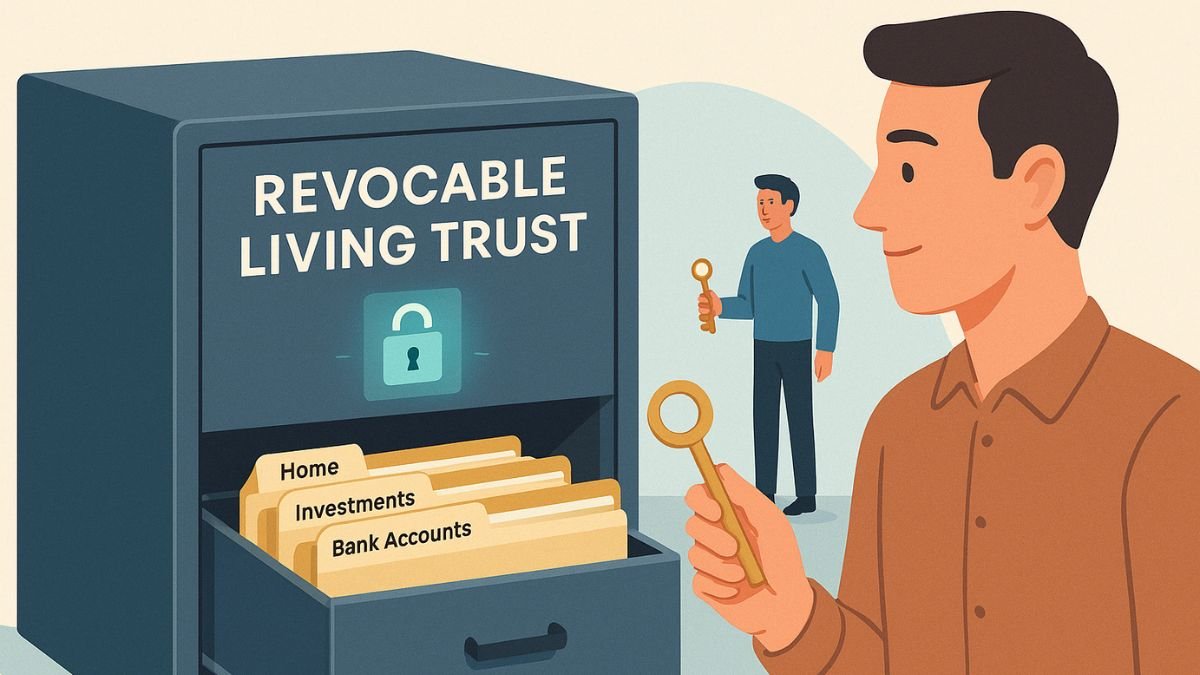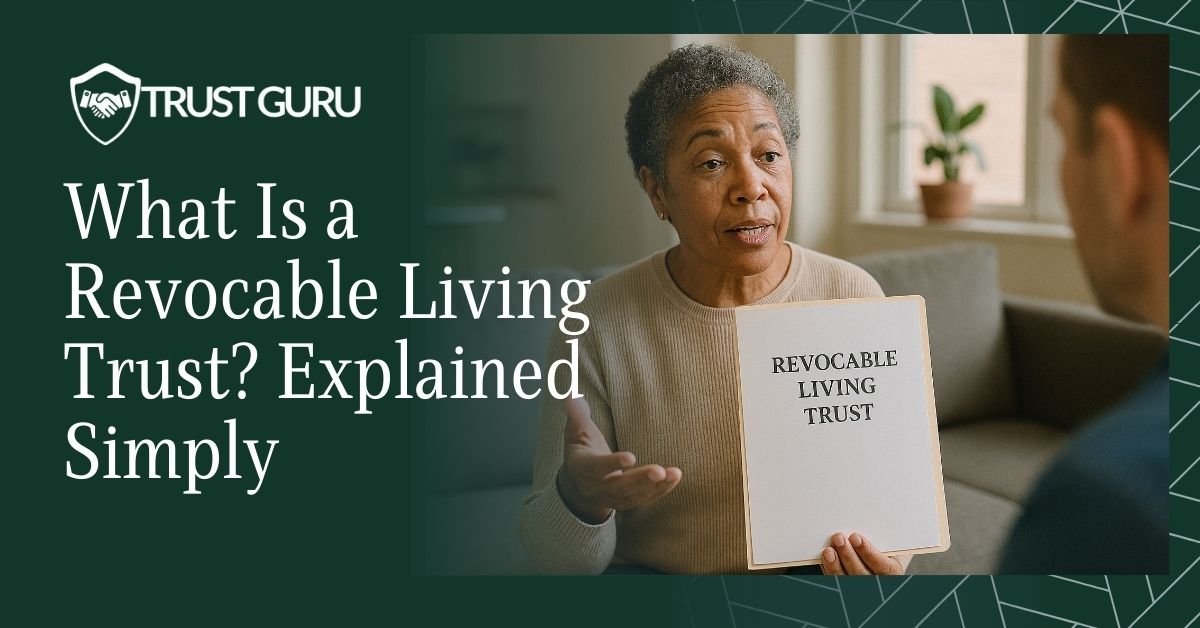If you’ve been searching for a clear, no-nonsense guide to estate planning tools, you’ve likely come across the term revocable living trust. But what does it actually mean—and do you really need one? This article offers a revocable living trust explained simply, helping you understand how it works, what it offers, and when it might make sense for your personal or financial situation.
Whether you’re planning for retirement, protecting your assets, or preparing to pass them on smoothly to your loved ones, this guide will walk you through everything you need to know—without the legal jargon or confusion.
What you’ll learn:
- What Is a Revocable Living Trust?
- How Does a Revocable Living Trust Work?
- Key Benefits of a Revocable Living Trust
- When Should You Consider Using One?
- Potential Drawbacks to Keep in Mind
- How a Revocable Living Trust Fits Into Your Estate Plan
- FAQs About Revocable Living Trusts
Let’s start by looking at what a revocable living trust actually is.

What Is a Revocable Living Trust?
A revocable living trust is a legal arrangement that allows you to place your assets—like your home, investments, or bank accounts—into a trust while you’re still alive, with the flexibility to manage, change, or even cancel it at any time. Think of it as a flexible container that holds your valuables and instructions for how they should be handled during your life and after you pass away.
Let’s break it down:
- “Revocable” means you retain full control. ou can amend the trust, add or remove assets, change beneficiaries, or dissolve it entirely—without needing court approval.
- “Living” indicates that the trust is created while you’re alive (as opposed to a testamentary trust, which is created through a will after death).
- “Trust” refers to the legal entity that holds your assets and outlines how they should be managed.
In a revocable trust, you typically serve as the grantor (the person creating the trust) and the trustee (the person managing it). You also name a successor trustee to take over management when you’re no longer able or after you pass away, along with beneficiaries who will receive the assets.
How Is a Revocable Living Trust Different from a Will?
While both a revocable trust and a will allow you to distribute your assets after death, they function very differently:
| Feature | Revocable Living Trust | Will |
| Goes into effect | Immediately upon creation | Only after death |
| Avoids probate | Yes | No (must go through probate court) |
| Privacy | Private – not part of public record | Public – filed with the court |
| Incapacity planning | Yes – successor trustee can step in during illness | No – requires additional documents (e.g., POA) |
| Ease of updates | Flexible – can be changed anytime | Requires formal updates or re-execution |
For a full breakdown of how these trusts compare, read our article on revocable vs irrevocable trusts.
An Everyday Analogy
Imagine a revocable living trust as a file cabinet where you store important items (your assets) along with instructions for what happens to them. As long as you’re alive and well, you hold the key and can open, rearrange, or remove anything. If something happens to you, the person you trust (your successor trustee) takes the key and follows your instructions—without court involvement.
Takeaway: A revocable living trust gives you control, flexibility, and peace of mind—making it a powerful foundation for a well-organized estate plan.

How Does a Revocable Living Trust Work?
A revocable living trust is more than just a legal document—it’s a living framework for managing your assets over time. Understanding how it works in practice can help you see why it’s such a valuable tool for estate planning.
Here’s a step-by-step look at how it functions, from the moment it’s created through the end of the estate distribution process.
1. Creation and Setup
The process starts when you, the grantor (also called the settlor or trustor), create the trust document. This outlines the rules of the trust—who manages it, who benefits from it, and what happens when you pass away.
You’ll also name:
- Trustee – usually yourself while you’re alive. You remain in control of your assets.
- Successor Trustee – the person or institution that will manage the trust if you become incapacitated or after you pass away.
- Beneficiaries – the people or organizations who will receive your assets later.
2. Funding the Trust
Once the trust is created, you “fund” it by transferring ownership of your assets into the trust. This may include:
- Real estate titles
- Bank and investment accounts
- Business interests
- Personal property
Although these assets now belong to the trust, you still control them as the trustee. Need help figuring out how to do this? See our complete guide on how to fund a living trust.
3. During Your Lifetime
As long as you’re alive and mentally competent:
- You maintain full control over the assets in the trust.
- You can add, remove, or change assets or beneficiaries at any time.
- You can revoke the trust entirely if your plans or circumstances change.
This flexibility is what makes a revocable trust so appealing.
4. If You Become Incapacitated
If you’re unable to manage your affairs—due to illness or injury—your successor trustee steps in to manage the trust according to your instructions. This avoids court intervention and ensures continuity in asset management.
5. After Your Death
Once you pass away:
- Your successor trustee takes over.
- They follow your instructions to distribute assets to beneficiaries.
- No probate court is involved, which means faster and more private asset distribution.
Wondering what happens to your home or other property after it’s in the trust? Check out this helpful breakdown on what happens to homes in trusts after death. The trust becomes irrevocable at this point, meaning it can no longer be changed.
Sarah & Mike’s Trust Story
Sarah and Mike, a married couple in their early 60s, created a revocable living trust to prepare for retirement. They placed their home, investment accounts, and savings into the trust. As co-trustees, they maintained control. When Mike developed early-stage dementia, Sarah seamlessly took over as sole trustee—without any legal red tape. After both passed, their adult children received the estate within weeks, without going through probate.
Takeaway: A revocable living trust works behind the scenes to manage and protect your assets—during your life, in the event of incapacity, and after your passing—all while keeping your plans private and under your control.

Key Benefits of a Revocable Living Trust
A revocable living trust offers several practical advantages that go beyond just passing on your assets. Whether you’re trying to simplify your estate, protect your privacy, or plan ahead for unexpected life events, a revocable trust can serve as a powerful tool in your estate planning strategy.
Here are the key benefits, broken down for clarity:
Avoiding Probate
One of the biggest advantages of a revocable living trust is that it allows your assets to bypass probate—the often lengthy and public court process required to validate a will.
- Why it matters: Probate can take months (sometimes over a year), involves legal fees, and exposes your estate to public scrutiny.
- How the trust helps: Since the trust owns your assets, your successor trustee can distribute them directly to your beneficiaries without court involvement.
Example: If you own property in multiple states, each location would require its own probate process. A trust avoids this completely by enabling a streamlined, centralized distribution.
Maintaining Privacy
Unlike a will, which becomes a public record after death, a revocable trust keeps your estate matters private.
- Beneficiaries, asset details, and your final wishes stay confidential.
- This is especially helpful for families who value discretion or want to reduce the risk of disputes.
Flexibility and Control
A revocable trust gives you total control during your lifetime. You decide how assets are distributed as income, when, and to whom:
- You can modify, update, or revoke the trust at any time.
- You decide how assets are distributed, when, and to whom (e.g., staggered distributions for young adult beneficiaries).
This flexibility is ideal for evolving life situations—whether you’re managing investments, going through a divorce, or adjusting to new family dynamics.
Planning for Incapacity
If illness, injury, or cognitive decline leaves you unable to manage your affairs, a revocable trust ensures that someone you trust can step in—without court intervention. In some cases, you may also want to have healthcare directives and powers of attorney in place.
- The successor trustee manages the trust according to your instructions.
- This avoids the need for court-appointed guardianship or conservatorship, which can be emotionally and financially draining for families.
For a second opinion on these benefits, here’s a useful breakdown on the advantages and disadvantages of revocable trusts.
Case Study: How John Avoided Probate and Simplified Estate Transfer
John, a retired engineer with a vacation home in Florida and a primary residence in New York, set up a revocable living trust to hold both properties and his brokerage accounts. When he passed, his daughter—named as successor trustee—was able to immediately begin distributing assets. There were no probate delays, no court costs, and no public exposure of John’s estate. His family avoided stress, saved thousands in legal fees, and settled everything within weeks.
Takeaway: A revocable living trust offers peace of mind, privacy, and flexibility—protecting your legacy and making life easier for the people you care about most.

When Should You Consider Using One?
A revocable living trust isn’t just for the ultra-wealthy—it’s a practical tool for a wide range of individuals and families looking to organize and protect their assets. You should consider setting one up if you relate to any of the following scenarios.
- You Own Real Estate (Especially in Multiple States)
If you own a home—or more than one property—placing it in a trust can save your heirs from dealing with probate courts in each state where you own real estate. Consider real estate protection strategies to reduce liability exposure and streamline estate transfer. - You’re Planning for Possible Incapacity
None of us can predict health challenges, but a revocable trust can help ensure your financial affairs are managed smoothly if you’re unable to make decisions due to illness or injury. Having a plan in place can avoid court-appointed conservatorships—especially when paired with healthcare directives. - You Have a Blended Family or Complex Family Dynamics
Blended families often bring unique estate planning considerations. A trust allows you to customize how assets are distributed—fairly and clearly—helping to avoid misunderstandings or disputes. Learn how to handle these sensitive situations with this guide on navigating complex family dynamics in estate planning. - You Want to Avoid Court Involvement Entirely
Probate court proceedings can be time-consuming, costly, and emotionally taxing for loved ones. A trust can streamline asset distribution and reduce unnecessary legal hassles.
Takeaway: If you’re thinking about long-term financial security, family harmony, or simply reducing the burden on loved ones, a revocable living trust could be the right step forward—especially if you own property, have dependents, or want to plan for the unexpected.

Potential Drawbacks to Keep in Mind
While a revocable living trust offers many advantages, it’s not without its limitations. To make the best decision for your estate plan, it’s important to understand the potential downsides and responsibilities that come with using this type of trust.
It Takes Time and Effort to Set Up
Creating a revocable living trust is more involved than drafting a simple will. It requires thoughtful planning, the right legal guidance, and a clear strategy for managing your assets both during your life and after your death.
- You’ll need to work with a qualified estate planning professional to ensure the trust is properly drafted and meets your goals.
- The upfront process may feel more complex, but it can save your loved ones time, stress, and money later on.
Note: For a detailed look at setup fees and considerations, see our guide on how much it costs to create a living trust.
No Asset Protection from Creditors
Because you retain control over the trust and its assets while you’re alive, a revocable living trust does not protect you from creditors, lawsuits, or divorce settlements.
- If asset protection is your priority, an irrevocable trust or other strategies may be more appropriate.
- Upon your death, the trust becomes irrevocable, but that does not apply during your lifetime.
Requires Ongoing Asset Management
Setting up the trust is just the first step. To make it effective, you must fund the trust—which means transferring ownership of your assets into it.
- Property deeds need to be retitled in the name of the trust.
- Bank accounts, investment portfolios, and business interests should be formally moved into the trust.
- Any assets left out of the trust may still need to go through probate, defeating one of the key purposes of the trust.
Quick-Reference Checklist: Things to Ask Before Setting Up a Trust
- Do I own real estate or other high-value assets?
- Am I prepared to complete the necessary paperwork to fund the trust?
- Is avoiding probate and maintaining privacy a priority for me?
- Do I understand that this trust won’t shield my assets from legal claims while I’m alive?
- Have I spoken with an estate planning professional to explore my best options?
Takeaway: A revocable living trust offers significant benefits, but it also requires active involvement and won’t suit every need. By understanding these limitations up front, you can move forward with a solution that truly fits your estate planning goals.
How a Revocable Living Trust Fits Into Your Estate Plan
A revocable living trust is a powerful tool—but it’s just one part of a comprehensive estate plan. To ensure your wishes are fully carried out and your loved ones are protected, your plan should include multiple components that work together seamlessly.
One Piece of the Bigger Picture
A complete estate plan typically includes:
- A will: Even with a trust, you should still have a will drafted to catch any assets left out. You might also consider a special needs trust if you have dependents with disabilities.
- Durable power of attorney: Authorizes someone to make financial decisions on your behalf if you become incapacitated.
- Healthcare directive or living will: Provides instructions for medical care and designates someone to make healthcare decisions for you.
- Beneficiary designations: Ensures assets like retirement accounts or life insurance pass directly to named individuals.
Each of these documents serves a distinct purpose. Together, they form a safety net that helps avoid confusion, conflict, and legal obstacles during a difficult time.
Not a One-Size-Fits-All Solution
While revocable trusts offer privacy, flexibility, and probate avoidance, they aren’t ideal for every situation. Some people may benefit more from simpler plans or from additional strategies—like irrevocable trusts, charitable trusts, or family limited partnerships—depending on their goals and circumstances.
Estate planning should be tailored to your life stage, assets, family dynamics, and future intentions. That’s why it’s important to consult a professional who can help you design a plan that fits—not force you into a generic solution.
Ready to take the next step? Contact our team at Trust Guru for a free consultation and personalized guidance on whether a revocable living trust is right for your estate plan. Planning today means peace of mind tomorrow.
FAQs About Revocable Living Trusts
If you’re exploring revocable living trusts for the first time, it’s natural to have questions. Below are clear, concise answers to some of the most common inquiries people have when considering this estate planning tool.
No. A revocable living trust and a will are both used to distribute assets, but they function very differently. A will only takes effect after your death and must go through probate, a court-supervised process. A revocable living trust, on the other hand, takes effect immediately, allows your estate to avoid probate, and includes provisions for managing your assets if you become incapacitated.
When the grantor (you) passes away, the revocable trust becomes irrevocable, meaning it can no longer be changed. The successor trustee then steps in to manage and distribute the assets according to your instructions—without needing probate court approval. This allows for a smoother, faster, and more private estate settlement process.
While it’s possible to create a trust using online templates, it’s highly recommended to work with an experienced estate planning professional. A trust must be tailored to your specific needs, properly funded, and compliant with your state’s laws. Mistakes in setup or asset transfer can undermine the very purpose of creating a trust.
Yes. As the grantor, you can modify or revoke the trust at any time during your lifetime, as long as you are mentally competent. This includes changing beneficiaries, adding or removing assets, or adjusting instructions based on life changes like marriage, divorce, or the birth of a child.
Common assets to include are:
Real estate (homes, rental properties, vacation homes)
Bank accounts and investment portfolios
Business interests
Valuable personal property (art, jewelry, collections)
Life insurance policies (as ownership or beneficiary designation)
Retirement accounts like IRAs and 401(k)s are generally not placed directly into a trust, but beneficiary designations can be coordinated as part of your estate plan.













